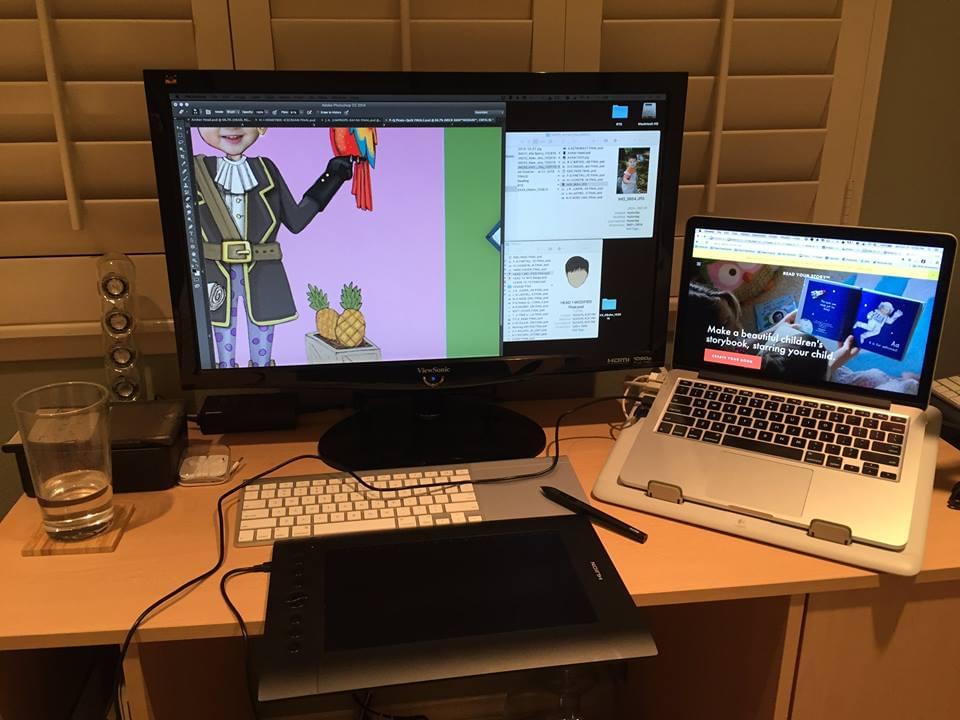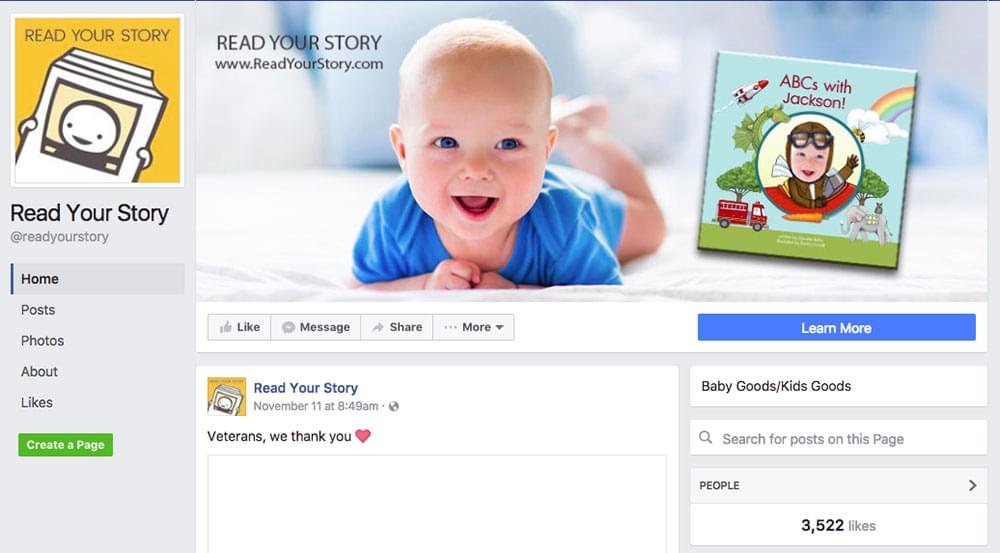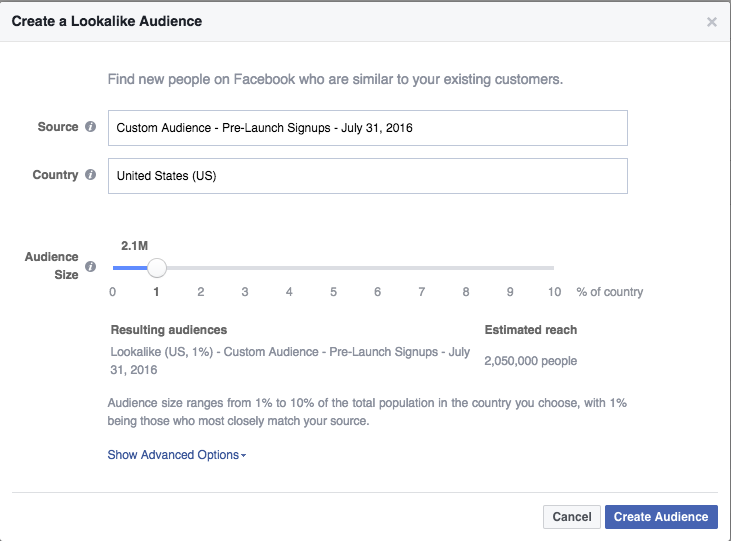We Quit Facebook and Google to Build a Children’s Book Startup

Key Takeaways
- The founders of the children’s book startup, Read Your Story, identified a gap in the market for high-quality personalized children’s books that merge names and pictures into the story.
- The startup’s initial run was not designed to turn a profit, but rather to validate the product/market fit. The founders made 50 books and despite a poor user experience, the reaction was positive and demand was proven.
- To further validate demand before scaling the business, the founders built a customer list of 6,000 sign-ups through Facebook ads and a series of increasingly effective Lookalike audiences.
- The startup’s technology now allows parents to create their own books on the site, and automation has been implemented for order processing, quality assurance, printing, and delivery. The company is now ready to scale.
- Both founders left their jobs at Google and Facebook to focus on the startup, with the aim of scaling out the business with more titles and custom products in the coming year.

The story of my startup, Read Your Story, begins on a warm summer evening in July 2015, when my family was having dinner over at my sister’s house in Palo Alto, California.
While we were enjoying some wine, we watched our kids play in the backyard. As we were chatting, the conversation at some point turned to how much we loved storytime with our kids, since it’s an opportunity to bond and escape technology.
Like many other parents, we were concerned about limiting “screen time” for our own children.
The iPhone and iPad are magnificent devices, but they are also far too convenient as tools for zoning out unruly kids when we need a moment of peace.
My sister Jeanette — then a marketer at Google — asked an interesting question: is it possible to make books that are more engaging than an iPad for young kids?
We started to brainstorm and began to share some interesting observations about young children. We consistently noticed kids get excited when they see their own name in print, and also when they see pictures of themselves.
Why couldn’t we merge names and pictures into storybooks?
From this dinner followed several weeks of research, where my sister and I were surprised to discover that there were surprisingly few personalized children’s book companies that merged faces and names into books.
And the ones that existed were poor quality. We decided that we could do better.
As an experiment, we committed to a short-run book test to validate market demand.
At the time, I was working at Facebook as a product manager and wasn’t ready to leave my job.
We kept this project on a slow and steady burn as a side project.
Validating the Concept Through a First Run
After brainstorming a few book concepts, we decided to go with an “ABC” book, since it was a straightforward and popular book format for parents.
Jeanette ran some hefty diligence through her network and was able to connect with Donna — an incredible children’s book illustrator who brought our book to life. Donna later became our third co-founder.
The goal for our first run wasn’t to make money, but to validate directional product/market fit.
We committed to making 50 books.
When we were ready to launch our test in October, we had a really solid product to test with — but a terrible user experience.
I constructed a crude SquareSpace website that featured an awful shopping experience.
If you wanted to buy a book, you had to:
- Fill out a form with your child’s details, shipping details, and your email.
- Give us your credit card information to make a purchase.
- Our team would see the order and then email the customer soliciting a photo of their child.
- Upon receiving the customer’s photo, our team would manually crop the face into each page of the book.
- Finally, the book was sent to a printer and drop-shipped to the customer.
Each book took 3 hours to create in Photoshop.
There was a ton of manual drawing that was required for every page of the book — it turns out that masking artificial hair on top of a real face is quite challenging!

After creating a customer’s book, we would then export a high-quality PDF and upload it to Blurb.com, a really great but expensive photo book tool.
We sold each book for $35 on our website, and Blurb would then charge us $45 to print and deliver.
Most importantly, my sister and I wanted to get unbiased data that real people wanted our books. Consequently, we didn’t let any friends know about our project. We shared news of these books to lists and parent groups under aliases.
We also ran some light Facebook ads to drive brand awareness and a little direct response. We purposely held off on being too aggressive with marketing.
We wanted to see what customers would do with the books.
Fortunately, the reaction was really positive, even with the poor user experience. Our customers shared our site and told their friends, and much of our sales turned out to be organic via word of mouth.
No profit was made from this test run, but we were able to prove some demand for our idea.
How to get 6,000 customer signups before you launch
After our successful mini-run test, we decided to proceed with testing a more scalable version of our business. But first we wanted to build a customer list to further validate demand.
Even before fingers touch code to develop your cool new business, I’m a big believer that you have to determine market validation so that you can sell your product.
List building is one of the best levers to both validate product/market fit, as well as line up customers from day one.
The co-founders at Read Your Story had a strong gut-feel that our customized children’s books would be received well in the market. However, we were starting a brand from scratch. How the hell were we going to validate scalability for our business?
For us, we did that through Facebook ads.
Step 1: Get Likes to your Facebook Page

We kicked things off by setting up a simple Facebook page.
A nice logo, nice cover image, and a few cute posts. Then, we launched a Facebook ad campaign that was optimized for people to like our Page.
I’m a former Facebook Ads product manager, and do not generally recommend optimizing for Likes
Basically what happens when you do this is that the audience that Facebook targets focuses more on people who are ‘Like-y’.
That is, you’ll get people who just tend to Like everything that they see. Thus, the audience that you attract via these kinds of campaigns may not be a true signal of actual people who are interested in your product, but it is at least some rough signal.
Didn’t matter for me though. My primary focus was a single number: 100.
I wanted to put together a rough audience that had a general interest in my company, and aggregate 100 of these people.
Once I hit that number, I would then be able to run a Lookalike audience off those fans (you need a minimum of 100 fans to run Lookalike ads).
Step 2: Run Better & Better Lookalikes

Lookalikes are your best friend.
The basic idea here is that you can upload a custom audience list to Facebook, and the Facebook algorithm will parse commonalities among those people and extrapolate thousands or up to millions of ‘similar’ people who match the profile of folks on that list.
Lookalikes is an extremely powerful tool that Facebook offers its advertisers. In my opinion, it is one of the very best ways to target high-intent customers for your business.
So as I was developing the ads, I was constantly re-building my Lookalikes until they got to the point where I had some awesome customers to target.
First it started with running a Lookalike against fans of my Facebook Page. It was crude, but the fan signal was enough to get started.
I started running ads against that initial fan list and sent people into a landing page to sign up for our pre-launch. In the early days, it worked out to be around $5 per sign up.
Then, once I got to 100 people who signed up for my pre-launch via my landing page, I uploaded that list of people to Facebook as a custom audience and created another Lookalike audience from it.
This was a much better audience to build from (since they were fans who opted to give their email), and I began running ads against this audience. The sign up rate improved and I was paying about $2 per sign up.
I kept this process going to run ads, get more signups, build new custom audiences, create new lookalikes — until I got to the point where signups cost me well under $1 per email and my targeting became very effective.
Step 3: Don’t Ignore the Landing Page

Optimizing for better Lookalike audiences is really important for Facebook Ads, but the cheapest way to get there is to have a stellar landing page.
I made almost 20 permutations of our landing pages during my ad tests, and ultimately a few obvious lessons emerged that allowed me to achieve up to a 28% signup rate.
- A picture is worth a thousand words – Invest in good creative that tells your company story or explains your product.
- Big freaking sign-up field and button – Bigger the better.
- Keep it simple – Less on the page is better, don’t distract from people signing up.
I made all of our landing pages using a great WYSIWYG website platform called Webflow. Drafting these pages took no time at all with this tool.
Pre-launch landing pages aren’t an area where you need to invest in real tech, even SquareSpace or Weebly is sufficient at this stage.
Now that you have your big list, launch!
After running the process described above, we built our list to about 6,000 customer sign-ups.
It’s been a few weeks since we’ve launched and we’ve enjoyed brisk sales, thanks in large part to the wonderful pre-launch list that we built.
This list is going to be a big part of our marketing efforts moving forward, and I look forward to growing it to over 100K subscribers in the coming year.
Our method of growing our list wasn’t cheap — it cost us north of $5,000, but we are able to offset that cost now through book sales. Remember, these emails are worth a lot more than the cost of obtaining them if you can set up a funnel that converts.
The most important role that the pre-launch list played for our team was validating product/market fit. It was satisfying and motivating for our team to see how easy it was to gather customer emails as we were developing our product.
While we were building our list and building our product, we’d also enjoy frequently receiving a customer e-mail asking about when we’d go live. The customer queries supercharged our team and made us feel accountable to ship an awesome product from day one.
Where We Are Today
We are now a team of seven: 3 co-founders, 3 engineers, and 1 web designer. And our business is ready to scale.
We have built technology to allow parents to create their own books on our site, as well as invested in automation for order processing, quality assurance, printing, and delivery. I feel confident that we can fulfill thousands of orders per month easily, even with our tiny team.
In the past few months, my sister left Google and I left Facebook to open up more bandwidth on this project. We look forward to scaling out our business with even more titles and custom products in the coming year.
Frequently Asked Questions about Starting a Children’s Book Startup
How do I start a children’s book startup without the help of Facebook and Google?
Starting a children’s book startup without the help of Facebook and Google can be challenging but not impossible. The first step is to have a clear vision and mission for your startup. This includes understanding your target audience, the type of books you want to produce, and how you plan to distribute them. Next, you need to create a business plan that outlines your strategies for marketing, sales, and operations. You can use alternative marketing platforms like LinkedIn, Twitter, or Instagram to promote your books. Additionally, you can leverage email marketing, content marketing, and SEO strategies to reach your target audience.
What are the key elements to consider when writing a children’s book?
Writing a children’s book requires a unique approach. The key elements to consider include the age group you’re targeting, the theme of the book, the language used, and the illustrations. The story should be engaging, educational, and age-appropriate. The language should be simple and easy to understand. The illustrations should be colorful and appealing to children. It’s also important to consider the length of the book as children have a shorter attention span.
How can I make my children’s book startup stand out in the market?
To make your children’s book startup stand out in the market, you need to offer something unique and valuable to your target audience. This could be in the form of innovative storytelling, unique illustrations, or educational content. You can also differentiate your startup by focusing on a specific niche, such as books for children with special needs or books that promote diversity and inclusion. Additionally, having a strong online presence and engaging with your audience through social media and other platforms can help you stand out.
What are some of the challenges I might face when starting a children’s book startup?
Starting a children’s book startup comes with several challenges. These include finding the right authors and illustrators, securing funding, marketing your books, and competing with established publishers. Additionally, you need to ensure that your books are of high quality and meet the needs and preferences of your target audience. It’s also important to keep up with the latest trends in children’s literature and adapt your strategies accordingly.
How can I secure funding for my children’s book startup?
Securing funding for your children’s book startup can be done through various avenues. You can seek investment from angel investors or venture capitalists who are interested in the publishing industry. You can also apply for grants and loans from government agencies and non-profit organizations that support startups. Crowdfunding platforms like Kickstarter and Indiegogo are another option. Additionally, you can consider self-funding if you have the means to do so.
How can I market my children’s books without the help of Facebook and Google?
Marketing your children’s books without the help of Facebook and Google can be done through various strategies. You can leverage other social media platforms like Instagram, Twitter, and LinkedIn. You can also use email marketing, content marketing, and SEO strategies to reach your target audience. Participating in book fairs and children’s events can also help you promote your books. Additionally, you can collaborate with schools, libraries, and other organizations that cater to children.
How can I distribute my children’s books?
There are several ways to distribute your children’s books. You can sell them directly through your website or through online retailers like Amazon. You can also partner with bookstores and libraries. Additionally, you can consider digital distribution through e-books and audiobooks. It’s important to choose a distribution method that reaches your target audience effectively.
How can I ensure the quality of my children’s books?
Ensuring the quality of your children’s books involves several steps. First, you need to work with skilled authors and illustrators who can create engaging and visually appealing content. Second, you need to have a thorough editing and proofreading process to ensure that the text is error-free. Third, you need to choose a reputable printer to ensure that the physical books are of high quality. Lastly, you need to gather feedback from your target audience and make improvements based on their suggestions.
How can I measure the success of my children’s book startup?
The success of your children’s book startup can be measured through various metrics. These include the number of books sold, the revenue generated, the feedback and reviews from your target audience, and the recognition and awards received. Additionally, you can measure the impact of your books on children’s learning and development.
How can I scale my children’s book startup?
Scaling your children’s book startup involves expanding your product range, reaching new markets, and increasing your sales. This can be done by creating more books, targeting different age groups, and exploring international markets. You can also consider diversifying into related products like educational toys and games. Additionally, you can leverage digital technologies to reach a wider audience and increase your sales.
Eric Bahn is the co-founder of Read Your Story, a personalized children's book company. In addition to running Read Your Story, he is a Venture Partner & Entrepreneur in Residence at 500 Startups, an early-stage venture capital firm. Earlier in his career he worked at Facebook and Instagram as a product manager, and for nearly a decade ran an education startup that was eventually acquired by The Daily Mail in 2012. Eric lives in the San Francisco Bay Area with his wife and son.
Daniel Graziano is the Head of Growth and Revenue at SitePoint. He leads all partnership, marketing and growth initiatives. In his spare time, you'll find him surrounded by good food (and people) or planning his next vacation.
Published in
�·APIs·CMS & Frameworks·Database·Frameworks·Laravel·Libraries·PHP·Web Services·February 29, 2016



